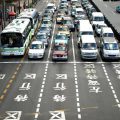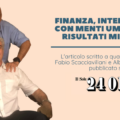Income is not the sole determining factor in quality of life; production is not the only thing that fuels a country’s growth. The entire healthcare sector—hospitals, treatments, and surgeries among others—has grown spectacularly, eliciting wealth, occupation, and improving patient satisfaction. In Singapore, I was treated for a bothersome disease that had been plaguing me for years. After years of research in addition to costly and useless specialized medical visits, doctors in Singapore found the origin of the problem and cured it rapidly. Now, I’m free of symptoms. The doctors were competent, the nurses kind, the hospital clean, and the organization perfect: there were no long waiting times or useless hospital stays for previously confirmed analyses. Rationality prevailed: time is a resource, and today red tape is expensive. It makes no sense—neither economic nor social—to keep patients waiting. The costs for them or to the collective society are enormous. You only need to look at the Italian healthcare budget to see this, even without analyzing service quality. There are objections, however: Singapore is an example of excellence. It’s too rich, small, and manageable to serve as a paragon. Its excellence is undeniable; it’s the fruit of unique circumstances and is likely unrepeatable. But Thailand is offering even more convenient solutions to keep up with Southeast Asia. Thai doctors—who have frequently studied in the US or Europe—are valuable but the cost of healthcare is decidedly lower compared to the city-state. As a result, the level of medical tourism is very high. Singapore hosted 600,000 people in 2014, and Thailand welcomed more than twice that at 1.4 million. It’s a familiar story: people travel to Bangkok, fix their teeth, get an electrocardiogram, go shopping, and top it off with a week at the beach in Phuket. It’s a method to enrich and diversify tourism, which contributes 10% of the Thai GDP with 25 million people per year. It represents the most delicate component because it’s subject to uncontrollable variables. The political situation is still uncertain after the umpteenth coup. International investors, vital for re-launching the manufacturing economy, are still timid after the Thaksin family saga. The military guarantees control but not development, and the country wavers between traditional pro-US alignment and the temptation to cede to Chinese pandering. The economy is moving slowly, and tourism remains an asset to safeguard. Business charters are arriving with middle-class European patients, the poor from Asian villages, and nascent Middle East bourgeoisie. They all bring hope and credit cards. Ironically, a 75-year old Omani woman came for rejuvenation and ended up requiring medical treatment. She was the first case of MERS (Middle East Respiratory Syndrome). The new respiratory epidemic is spreading fear and victims in Asia (especially South Korea), but it caused no alarm in Thailand. The patient was isolated and cured, and there was no panic in the greater population. Tourists continue to land because the country—despite its temporary difficulties—knows that it can grow if it offers and maintains safety, beauty, and efficiency. All at low costs.
Share

















